As of October 2020, there were 520 documented bird species in the state of Washington. Birdwatchers love visiting the state! It’s home to many colorful birds that reside and migrate to the state.
In this article, we’ll take a look at 25 of the most exciting birds in Washington.
Let’s get started!
25 Birds to Spot in Washington
Embark on your birdwatching journey with our extensive list of bird species. We made sure to include common birds you can find in your backyard and rare birds that are a little challenging to spot.
To make this list more accessible to our readers, we’ve also color-coded them!
Red Birds to Watch for in Washington
Purple Finch

- Scientific Name: Carpodacus purpureus
- Length: 4.7 to 6.3 inches
- Weight: 0.6 to 1.1 ounces
- Wingspan: 8.7 to 10.2 inches
The Purple finch greatly resembles the House finch and Cassin’s finch. They’re all usually found in the same places in Washington. You’ll commonly find them in mixed-forest lowlands and farmlands. They’re also found in rural areas and tend to avoid urban areas and large forests.
Purple finches are bright red on their heads and breasts and reddish-purple on the rest of their bodies. You can distinguish Purple finches from House finches by their bills. House finches have curved bills, whereas Purple finches have straight bills.
Although previously extremely common in Washington, Purple finch populations have declined since the eighties. They’re now outcompeted by House finches almost everywhere. Still, Purple finches are widespread and commonly found in Washington’s river valleys.
House Finch

- Scientific Name: Carpodacus mexicanus
- Length: 5.1 to 5.5 inches
- Weight: 0.6 to 0.9 ounces
- Wingspan: 7.9 to 9.8 inches
The House finch has a slightly longer tail and a curved bill. They’re closely related to Purple finches but are much more widespread. Up to 1.7 billion House finches live in North America!
The House finch’s most distinctive feature is its significant color variation between sexes. Some males can be bright orange or pale yellow! This usually correlates with their diet; bright red is still the most common color.
House finches love to sing! The males don’t stop all year round, and the females join in during the breeding season.
Blue Birds to Watch for in Washington
Belted Kingfisher
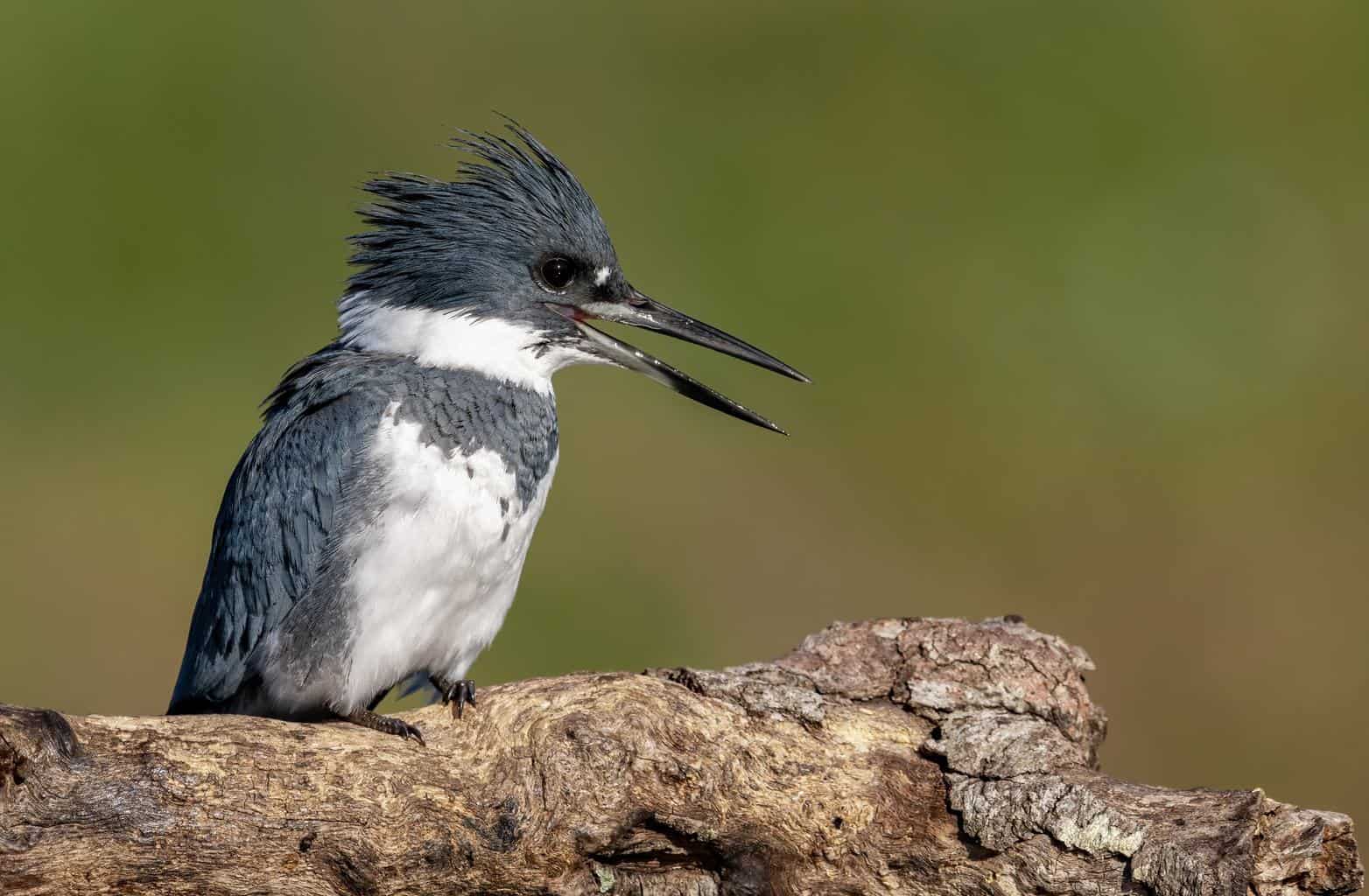
- Scientific Name: Megaceryle alcyon
- Length: 11 to 14 inches
- Weight: 4.9 to 6 ounces
- Wingspan: 19 to 33 inches
Belted kingfishers are majestic mid-size birds with large, blue heads and long bills. They have blue wings and a white belly, but the white collar makes kingfishers truly stand out.
You can find Belted kingfishers all year long. They like clear, open waters and are commonly found along rivers, coasts, and streams.
Belted kingfishers put on quite a show while hunting. They roam over the clear water looking for fish, tadpoles, or frogs. Once they spot an aquatic dweller, they dive headfirst and catch it with their beak.
Belted kingfishers are extremely aggressive when it comes to their territories. Once they spot an intruder, they let out a warning rattle sound, which is a sign a vigorous fight is about to commence.
Blue Jay
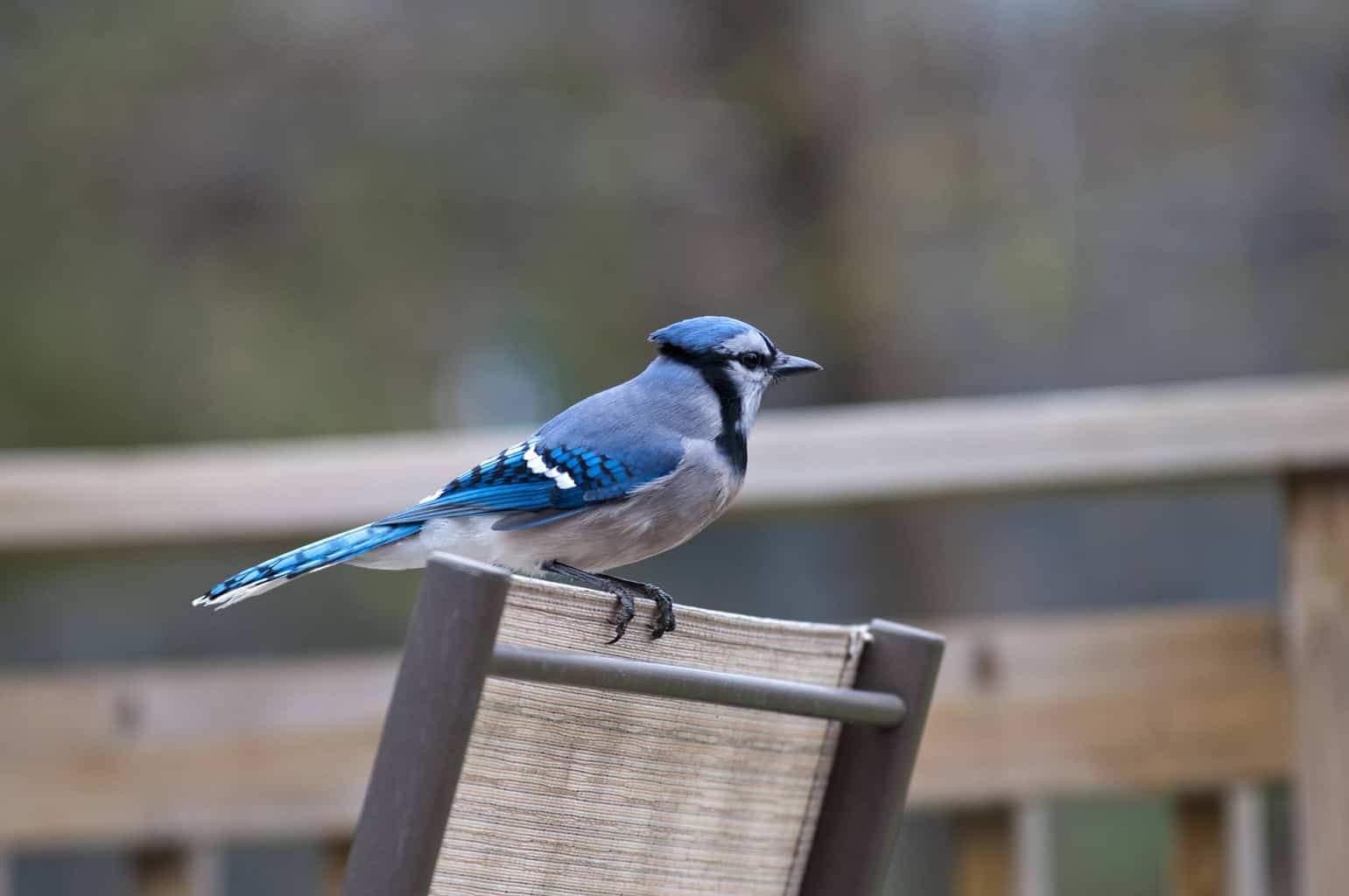
- Scientific Name: Cyanocitta cristata
- Length: 10 to 12 inches
- Weight: 2.5 to 3.5 ounces
- Wingspan: 13 to 17 inches
Although rare, Blue jays can visit in the winter and stay in mixed woods or park-like areas. They’re usually found in eastern Washington, the Columbia Plateau, or near the western lowlands. You can even spot one on the outer coast if you’re lucky.
This bird has a white underside, face, and throat. A black collar extends across its neck and white bars on its wings. Aside from that, everything else is blue. From the light blue crest and body to the more vibrant blue wings, it’s no surprise this is one of the most beautiful birds you can spot in the capital state.
If you see one Blue jay, there’s a good chance you’ll probably come across more. Blue jays travel in flocks and are generally not territorial. However, they can get pretty vicious when defending their nest site.
They’re also opportunistic feeders, meaning they take full advantage of any food source lying around. They can also start fights with other birds for food. Blue jays eat everything; they like frogs, rodents, nuts, eggs, and other vegetables.
California Scrub-Jay
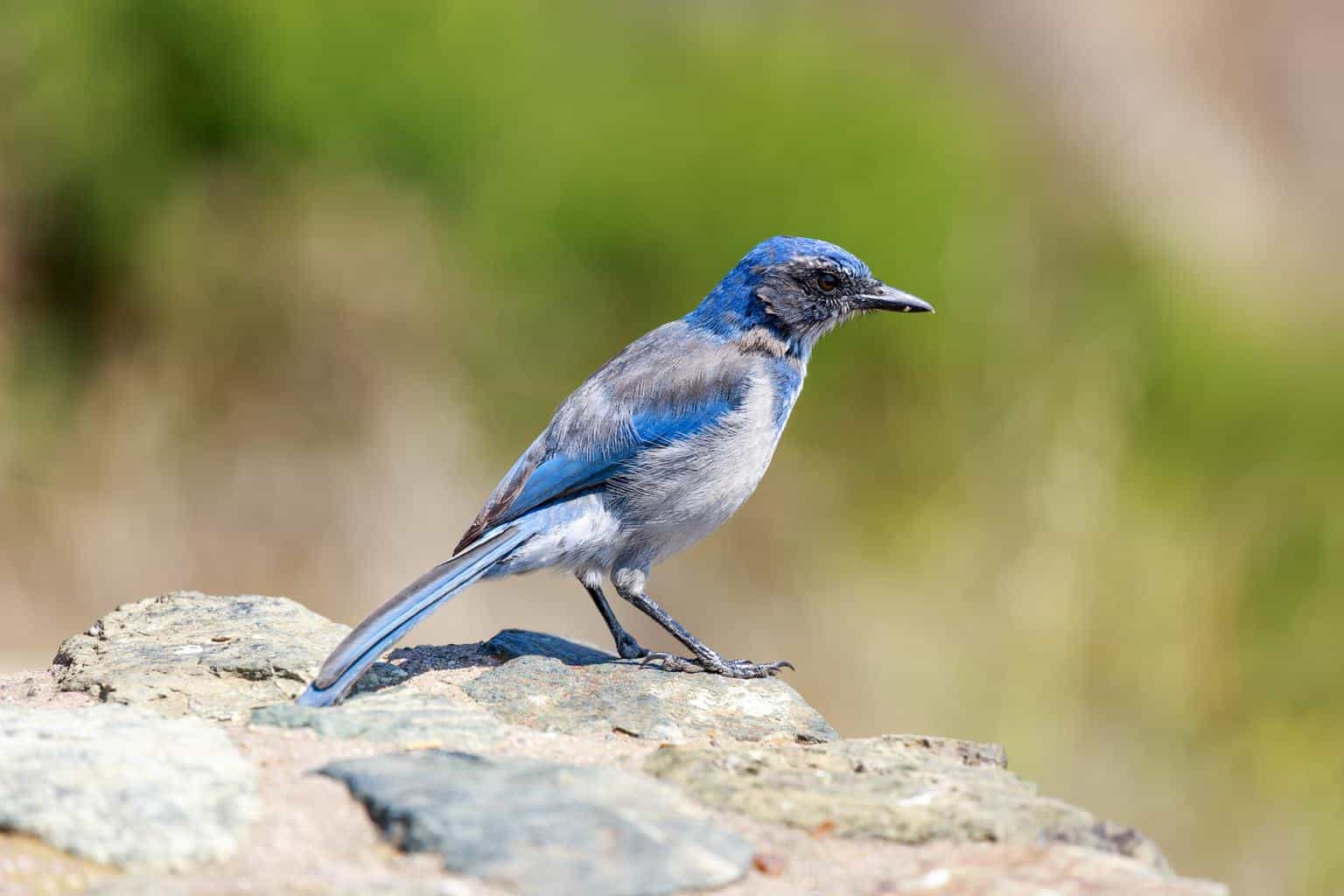
- Scientific Name: Aphelocoma californica
- Length: 11 to 11.8 inches
- Weight: 2.5 to 3.5 ounces
- Wingspan: 15.3 inches
California Scrub-jays are more popular than Blue jays. You can spot them all year round at Puget Sound in the south or the lowlands in western Washington.
These birds have slender figures and long tails. They’re blue with grayish-brown backs and underparts. Western Scrub-jays are found in family groups, small flocks, or pairs because they don’t forage alone, even outside of breeding season.
What’s interesting about California Scrub-jays is their diet. They’re generally omnivorous, but in the winter, they like to eat acorns, berries, and a variety of other seeds. In the summer, they feed on insects, snails, and spiders. They also eat small reptiles and amphibians.
Steller’s Jay
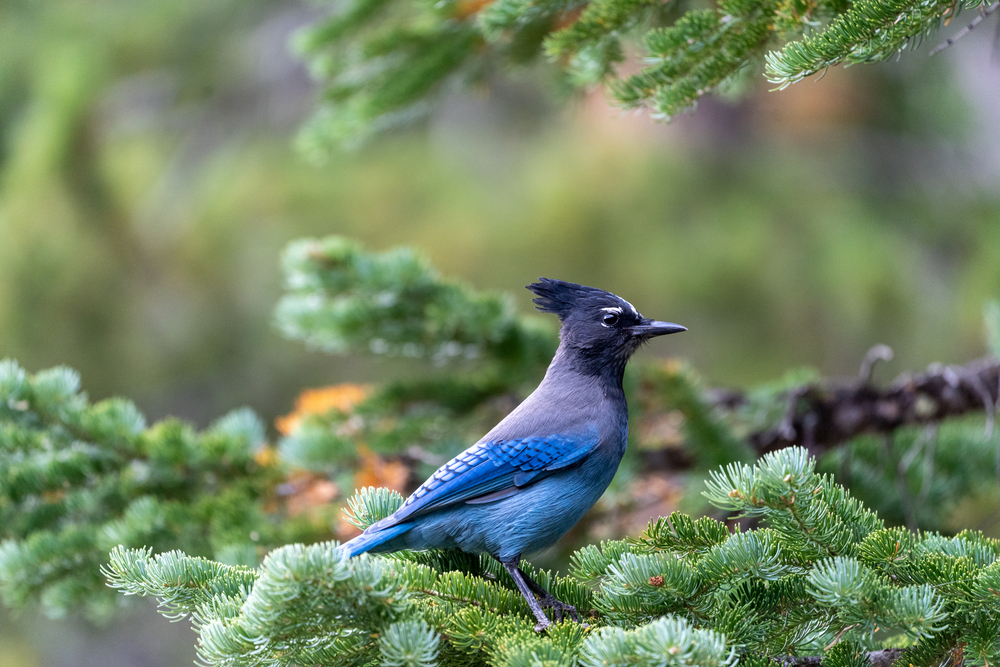
- Scientific Name: Cyanocitta stelleri
- Length: 11.8 to 13.4 inches
- Weight: 3.5 to 4.9 ounces
- Wingspan: 17.3 inches
Steller’s jays are residents of Washington. You can find them in most forested areas and the Olympic Peninsula. Steller’s jays have expanded in the state mainly due to residential development and bird feeders. You can even find some Steller’s jays in the Blue Mountains or the Columbia Plateau.
Steller’s jays have a striking deep blue plumage with some black on the head and body. These birds have characteristic ‘vertical’ eyebrows. The juveniles have browner heads and don’t grow their eyebrows until late in their development.
Steller’s jays are picky about their diet. Their food is about ⅓ animal matter and ⅔ vegetables. They like berries, fruits, nuts, and seeds, but they also go after invertebrates and small rodents. You’ll find that these birds have quite an appetite. They’re even known to eat the eggs of other species!
Green Birds in Washington
Pacific-Slope Flycatcher
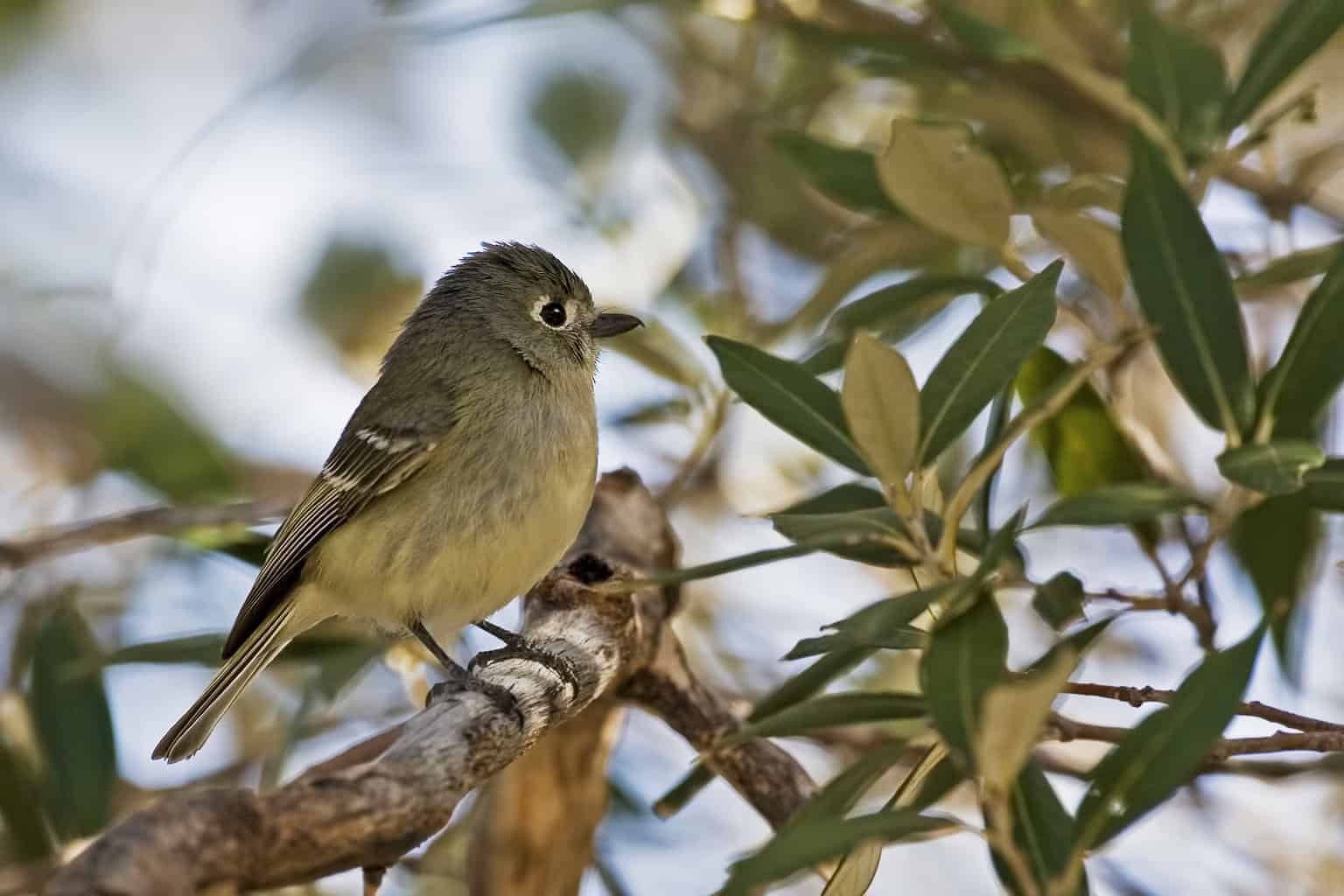
- Scientific Name: Empidonax difficilis
- Length: 5.5 to 6.7 inches
- Weight: 0.3 to 0.4 ounces
- Wingspan: 7.9 to 9.1 inches
Pacific-slope flycatchers were once a part of a bigger species called the Western flycatchers. In 1989, the species was split into the Cordilleran flycatchers and the Pacific-slope flycatchers.
Pacific-slope flycatchers are more common in Washington, but because both species meet in the southeastern part of Washington, a lot of cross-breeding takes place. These birds have greenbacks and yellow underbacks extending to their throats. They have a beautiful voice that makes it easy to distinguish them from other birds.
Pacific-slope flycatchers like to hunt down their prey in the air. They feed on flying insects and, uncommonly, crawling insects as well. You may blink and miss it, but you’ll definitely recognize their upslurred thin “tseep.”
Calliope Hummingbird
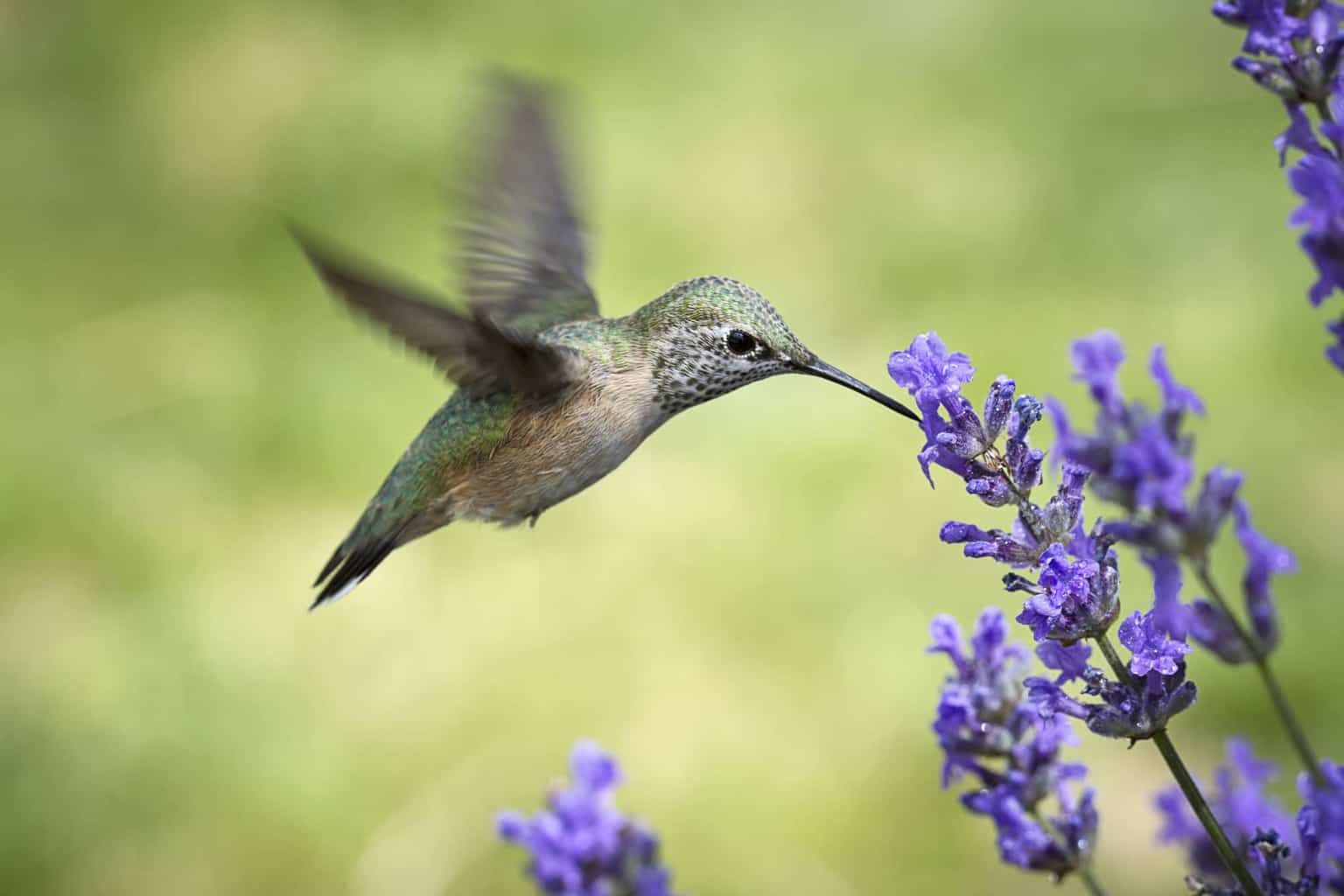
- Scientific Name: Stellula calliope
- Length: 3.1 to 3.5 inches
- Weight: 0.1 to 0.2 ounces
- Wingspan: 4.1 to 4.3 inches
Want to see the smallest hummingbird in Washington? The Calliope hummingbird is actually the smallest bird species in many countries, including northern Mexico!
Calliope hummingbirds have green bodies and an extremely distinctive pink throat patch. You can find them east of the Cascades and along the Skagit River in western Washington. You can also spot some of them in the meadows when it’s flowering.
These birds like to forage closer to the ground than most hummingbirds. Calliope hummingbirds put on an aerial display by diving and circling around each other or dancing in pairs.
Calliope hummingbirds like flower nectar and catching their prey in the air. A lucky Calliope hummingbird will occasionally catch an insect feeding on the sap of a flower.
The females do all the work during nesting. They build the nest, sit on the eggs, and feed the chicks until they leave the nest. Males don’t provide any parental care.
Black-Chinned Hummingbird
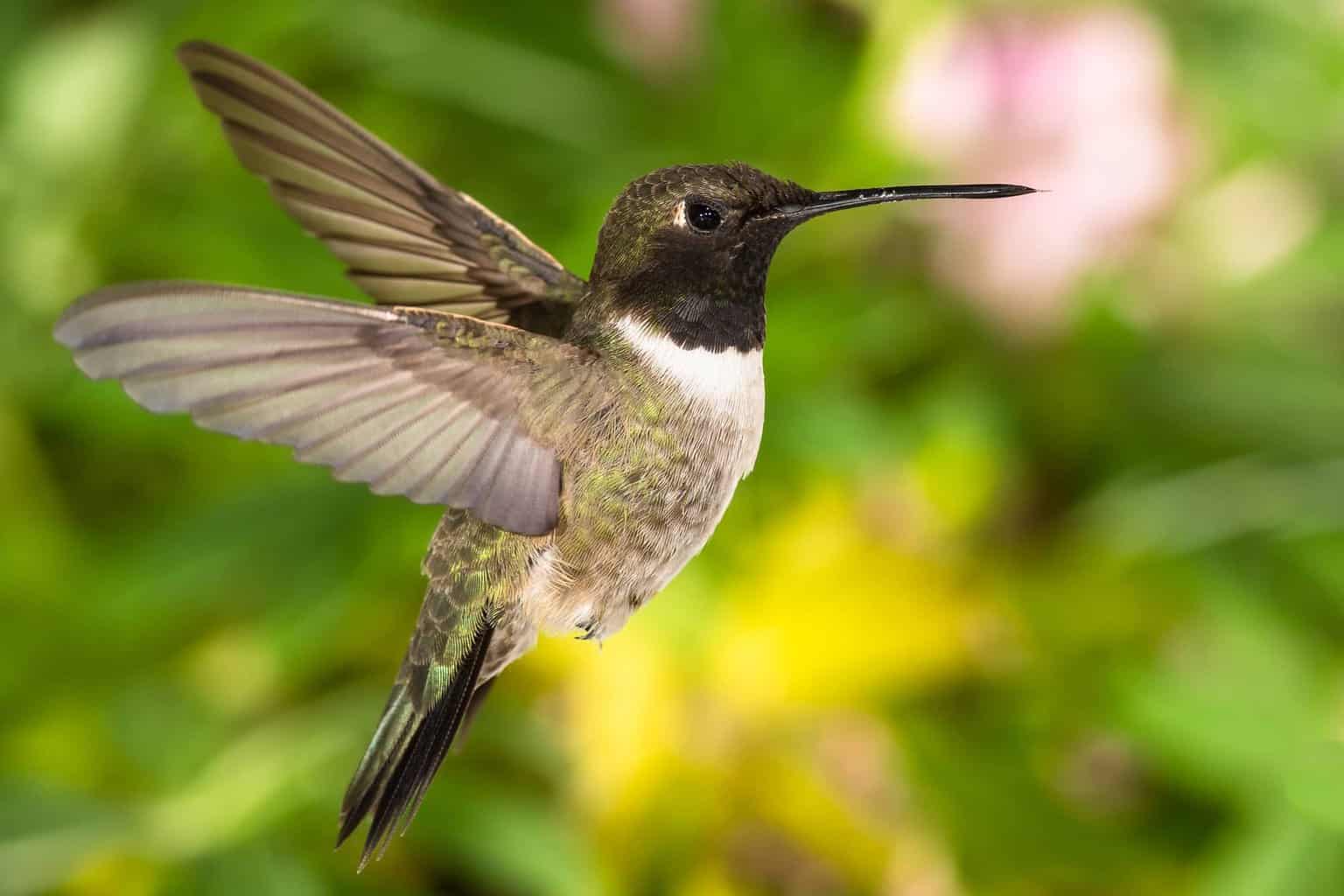
- Scientific Name: Archilochus alexandri
- Length: 3.5 inches
- Weight: 0.1 to 0.12 ounces
- Wingspan: 4.3 inches
Black-chinned hummingbirds have smaller frames and thinner necks than Calliope hummingbirds. They’re mostly green with white chests. They also have a distinctive purple band around their necks.
These hummingbirds are rare throughout Washington, but you can find them in vegetation zones, rivers, and wetland areas. Look for them at low elevations east of the Cascades and south of the Blue Mountains along the border of Idaho.
Black-chinned hummingbirds do aerial dances and feed on insects mid-flight. They also like to catch spiders, even from the ground. Like Calliope hummingbirds, the female does all the parental work and cares for the young till they’re independent.
Anna’s Hummingbird
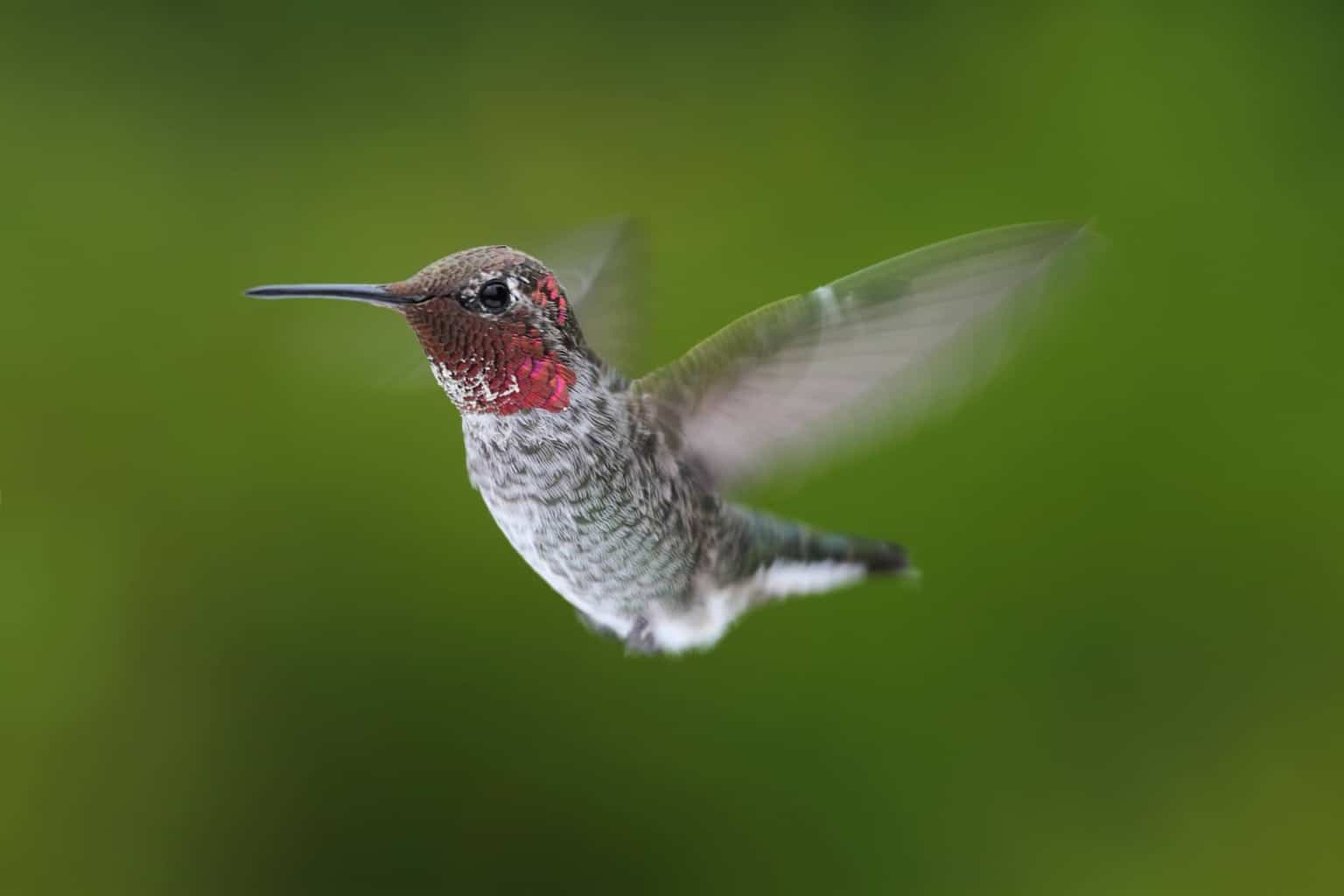
- Scientific Name: Calypte anna
- Length: 3.9 inches
- Weight: 0.1 to 0.2 ounces
- Wingspan: 4.7 inches
Male Anna’s hummingbirds have beautiful iridescent red heads and throats. They’re green and gray throughout their bodies, with a sloping forehead and a straight bill.
Anna’s hummingbirds were first spotted in Washington in 1976. They’re found in the lowlands of Puget Sound and throughout the Columbia Basin. You can also spot them in open woods or suburban gardens.
Male Anna’s hummingbirds like to make a “dive noise” when plummeting from high altitudes. The dive noise is a sharp popping noise that is very distinctive from other hummingbirds. These birds are vicious when fighting for territory or food, although the males defend more and for longer.
Orange Birds to Watch for in Washington
American Kestrel
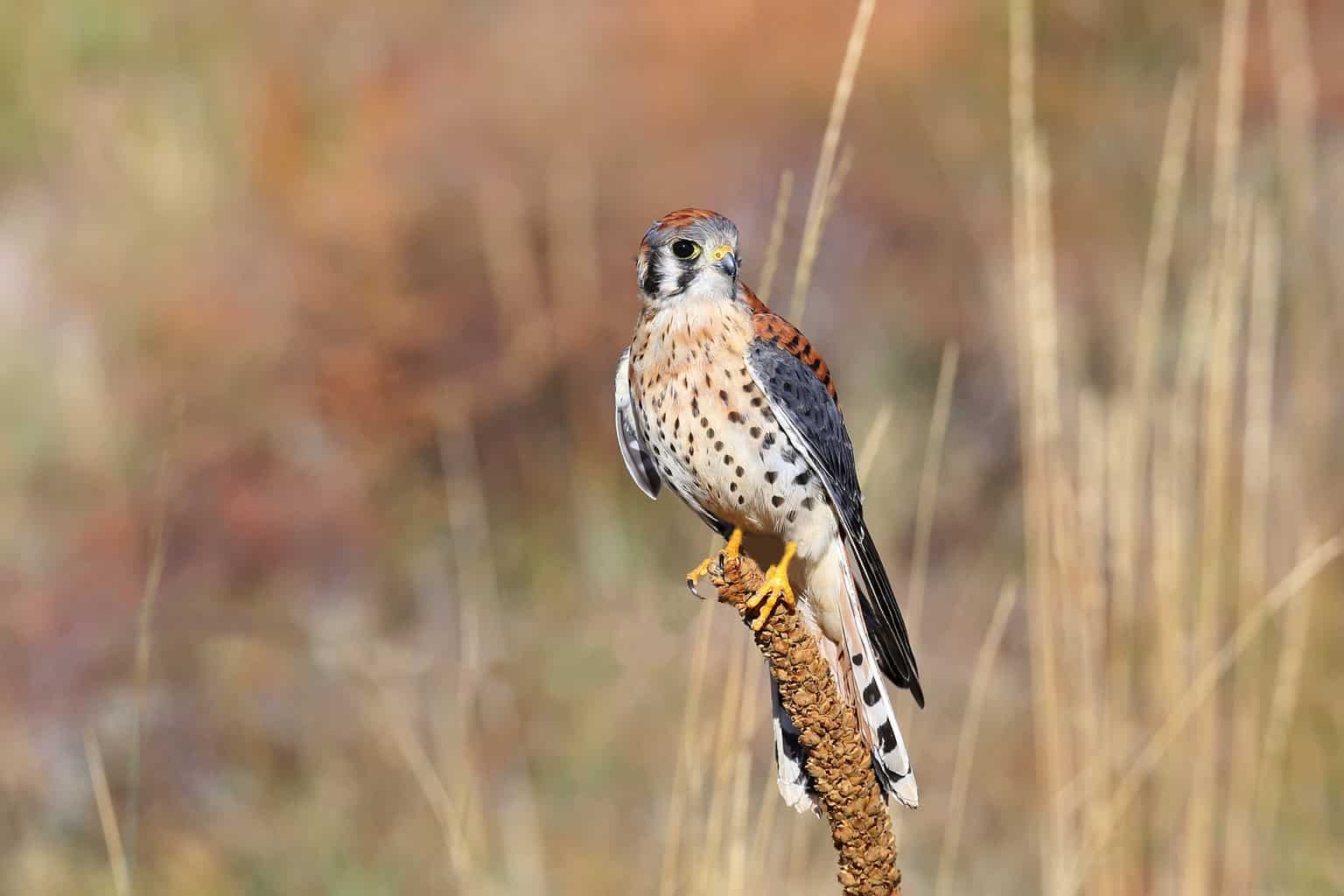
- Scientific Name: Falco sparverius
- Length: 9 inches
- Weight: 4.1 ounces
- Wingspan: 22 inches
The American kestrel is also called the sparrow hawk. It’s the most common raptor in North America and also the smallest.
These birds have orange plumage mixed with brown, blue, and white. They have black streaks on their wings and black spots on their breasts.
American kestrels are fairly common across eastern Washington. You can find them at lower elevations on agricultural lands and dry forests. You find them as frequently in western Washington, especially if you go northwest.
Although kestrels like low altitudes, you can spot them in high meadows and rocky areas up to 5000 feet up!
American kestrels feed on large insects, small birds and mammals, and, sometimes, reptiles.
Rufous Hummingbird
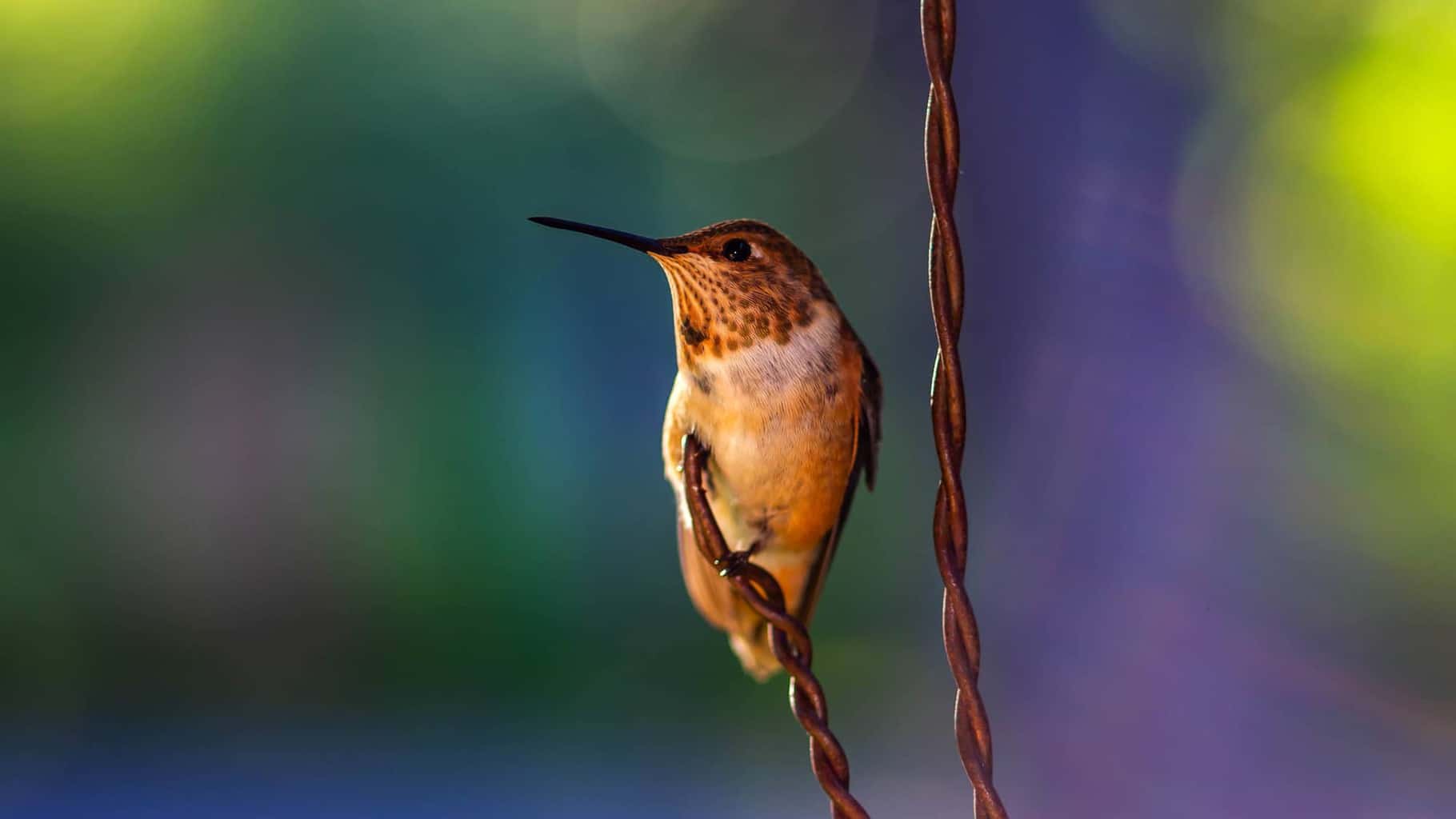
- Scientific Name: Selasphorus rufus
- Length: 3 to 3.5 inches
- Weight: 0.1 ounces
- Wingspan: 4 inches
Rufous hummingbirds have a striking orange color all over their plumage. They have green wings and white chests. The females have more green on them and are rufous at their tails.
Rufous hummingbirds like coniferous forests and sub-alpine habitats. That’s why you can find them near the Cascades and in the Ponderosa pine zone.
Like the other hummingbirds, Rufous hummingbirds like to feed on the nectar of flowers and insects. They especially love sugar water, salmonberries, and honeysuckles.
The male attracts the female by performing an aerial dance. They don’t like to sing but commonly let out warning chips when they feel in danger. Rufous hummingbirds are extremely territorial and will even fight other birds over their territories during migration!
Swamp Sparrow
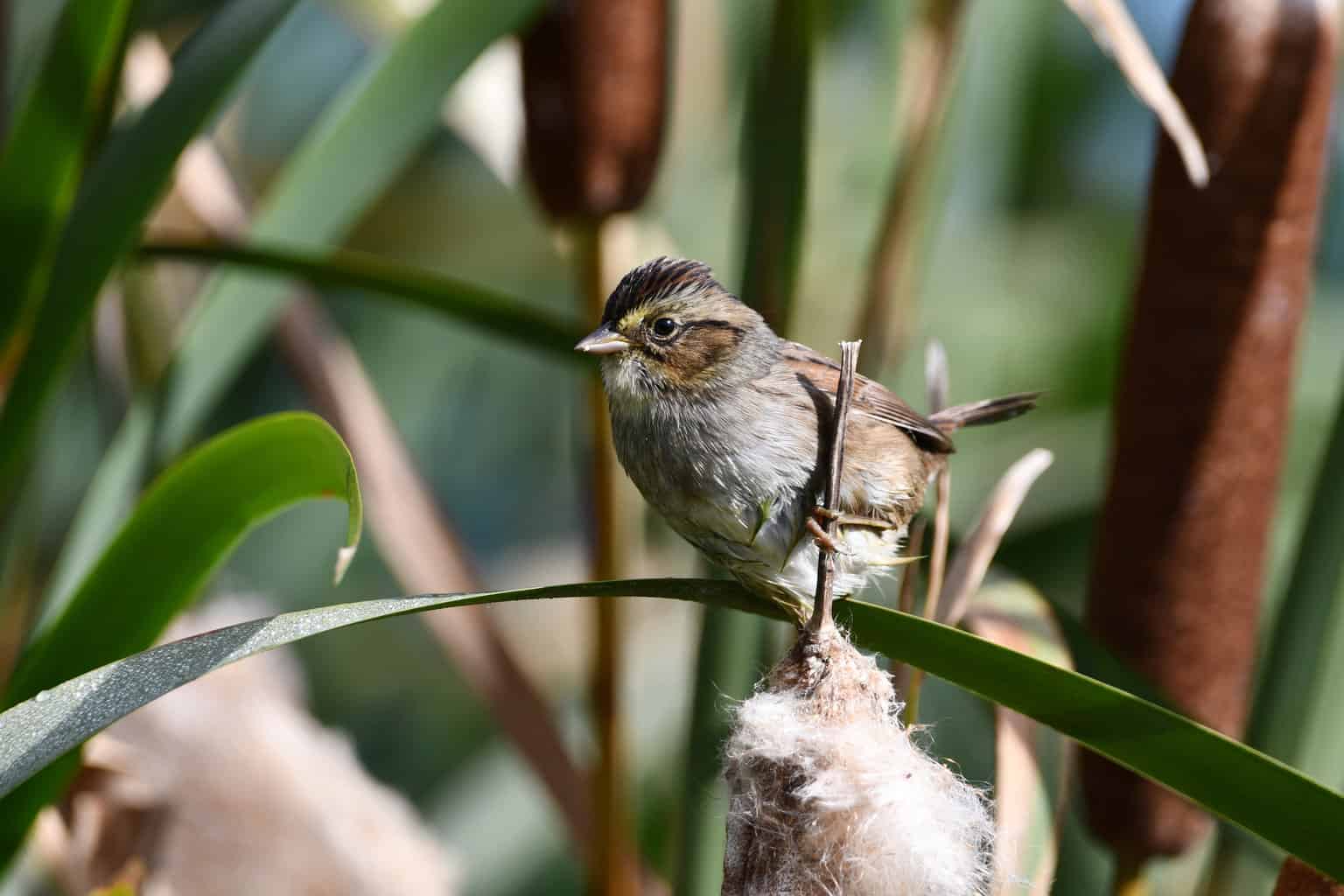
- Scientific Name: Melospiza georgiana
- Length: 4.7 to 5.9 inches
- Weight: 0.5 to 0.8 ounces
- Wingspan: 7.1 to 7.5 inches
Swamp sparrows are almost identical to Chipping sparrows. They share the same reddish-orange cap, but Swamp sparrows are a little bigger and much heavier. They also live in widely different habitats.
Swamp sparrows are rare in Washington, but you can spot one from October to March. If seen, they are usually somewhere around water. You can tell from the name that they like weedy, wet fields and swamps as a preference for breeding, hence the name Swamp sparrow.
Unlike most other sparrow breeds, Swamp sparrows mainly feed on insects, yet their diet also includes seeds. Around 90% of their diet is insects during the summer. However, this percentage significantly drops in fall and winter, when they change about 50% of their diet to seeds and fruits.
This type of sparrow is known to be a solitary bird. During their migration, they often join mixed-species flocks.
Yellow Birds to Watch for in Washington
Western Meadowlark
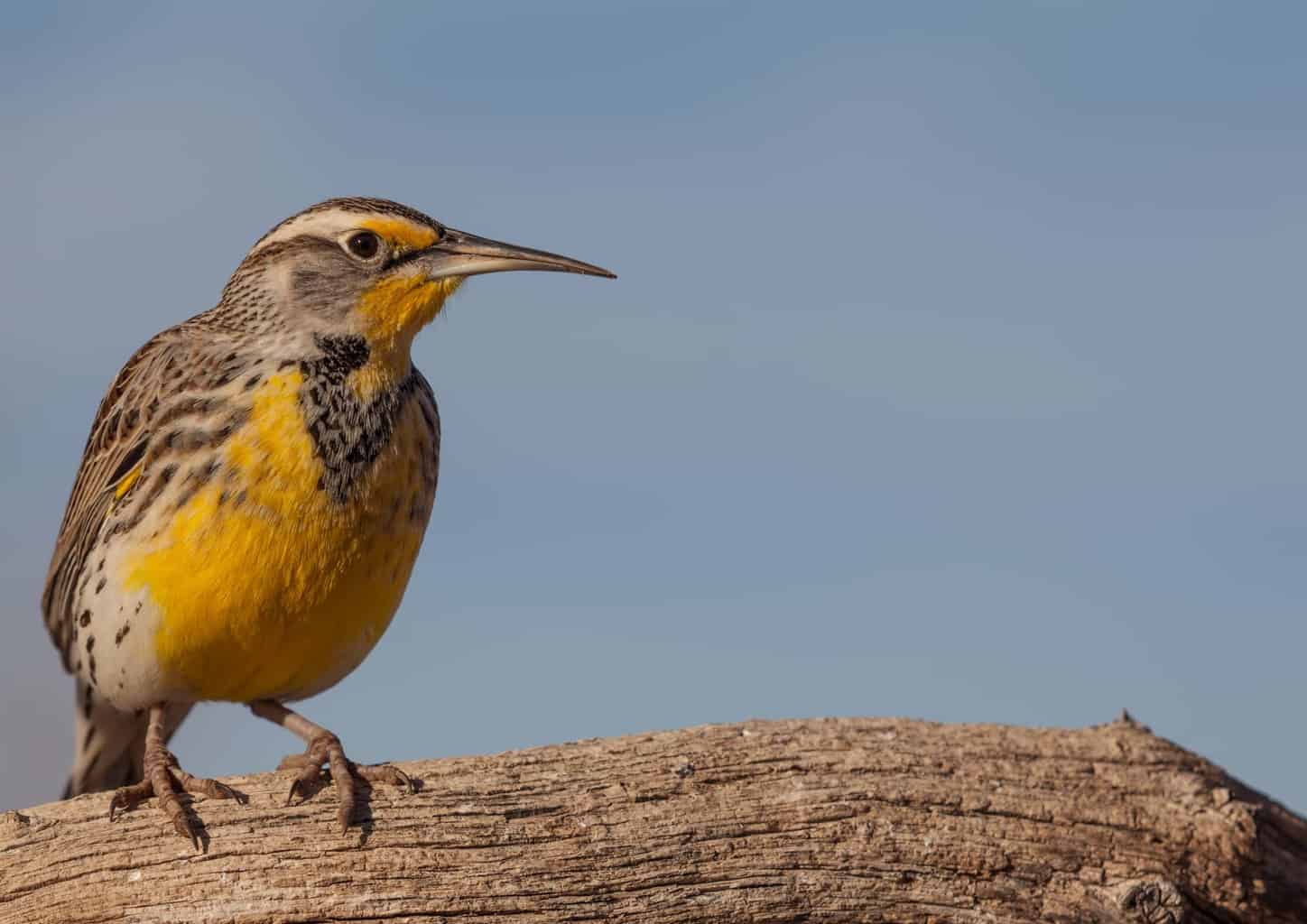
- Scientific Name: Sturnella neglecta
- Length: 6.3 to 10.2 inches
- Weight: 3.1 to 4.1 ounces
- Wingspan: 16.1 inches
Western meadowlarks can easily be distinguished from the other blackbird family members in Washington. They have intense solid yellow underparts and exceptional black collars. They also have streaked brown backs. Their short tails have obvious white feathers, which can be seen during flight.
Meadowlarks love green areas, as they are often found in shrub steppe and agricultural areas. They migrate in winter in single-species groups or with other members of the blackbird family.
During summer, the meadowlark’s diet is mainly made up of insects. Like Swamp sparrows, meadowlarks depend more on seeds and waste grain as the temperature starts to drop.
These birds are professional singers as they sing all spring. Also, they love to perform on stage, as they choose high structures or shrub tops to do all that singing!
Orange-Crowned Warbler
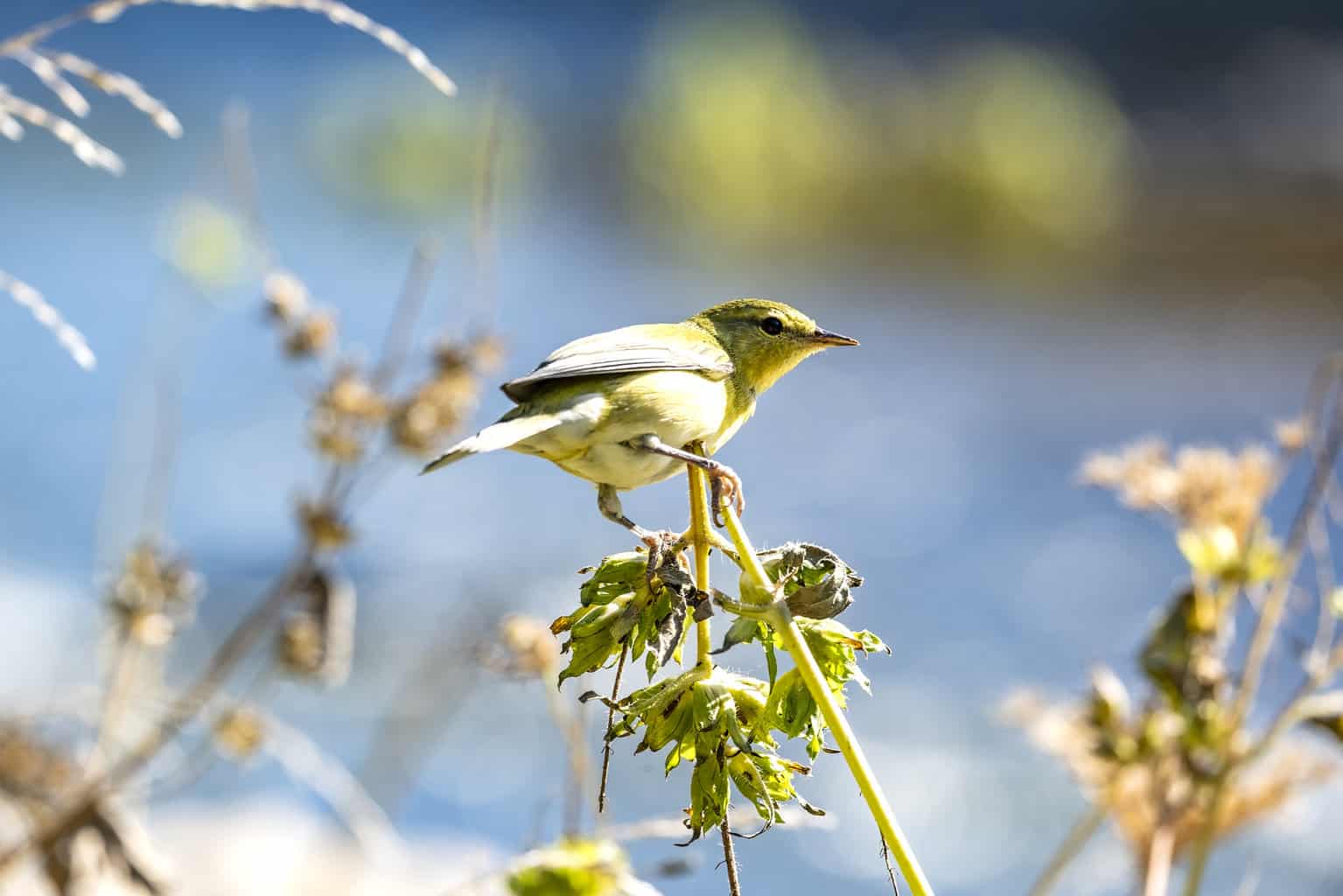
- Scientific Name: Vermivora celata
- Length: 4.3 to 5.5 inches
- Weight: 0.3 to 0.4 ounces
- Wingspan: 7.5 inches
Despite the name, Orange-crowned warblers have olive green backs with yellow chests. Males and females have orange crowns, but the female crowns tend to look a little browner.
These birds inhabit thick bushy areas and woodlands with willow and aspen. Being very small often encourages them to hide in small trees or bushes, seeking sanctuary.
The tiny warblers’ diet varies between insects, tree sap, and flower nectar, with insects being their main food source.
American Goldfinch

- Scientific Name: Spinus tristis
- Length: 4.2 to 5.4 inches
- Weight: 0.39 to 0.71 ounces
- Wingspan: 7.4 to 8.8 inches
Throughout Washington, the American goldfinch is the most common of all birds. It’s even called the state bird of Washington. With its dark forehead and striking yellow body, the goldfinch is commonly seen throughout Washington’s lowlands.
They inhabit weedy, bushy areas and can be found near rivers and fields. They specifically love thistles and can be found around them.
Needless to say, thistle seeds are the majority of the goldfinch’s diet. Like most birds, they also include insects, especially aphids, in their diet.
Goldfinches often flock during the non-breeding season. It’s common to see them accompany Pine siskins and redpolls in their flocks. Amid flight, you can hear them giving a lot of call notes.
Western Tanager
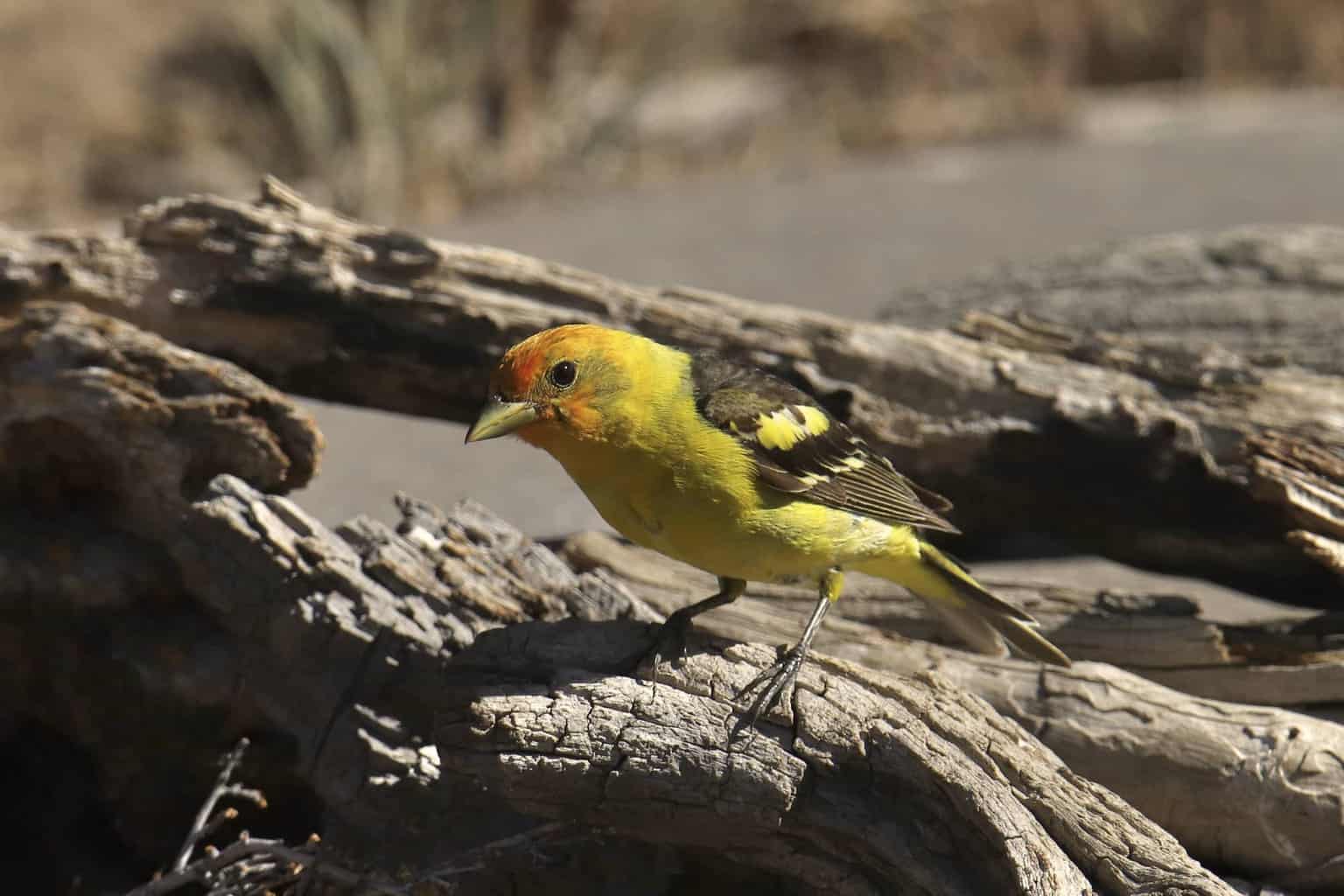
- Scientific Name: Piranga ludoviciana
- Length: 6 to 7 inches
- Weight: 0.8 to 1.3 ounces
- Wingspan: 11.5 inches
Regularly found in Washington, Western tanagers are the only kind of tanagers that visit Washington. They come to Washington in summer and fascinate us with their bright colors. They have reddish-orange heads, unmistakable yellow bodies, dark wings, and tails.
They have a very wide range of different habitats. They can be found primarily in dense forests, but that changes during migration when they can be found in orchards and shrub-steppe areas.
These tanagers are mainly insectivores during the breeding season. However, they consume a lot of fruits and flower nectar during the winter season.
Mostly, they collect their food from tree branches or catch aerial prey mid-flight.
Other Birds to Watch for in Washington
Northern Flicker
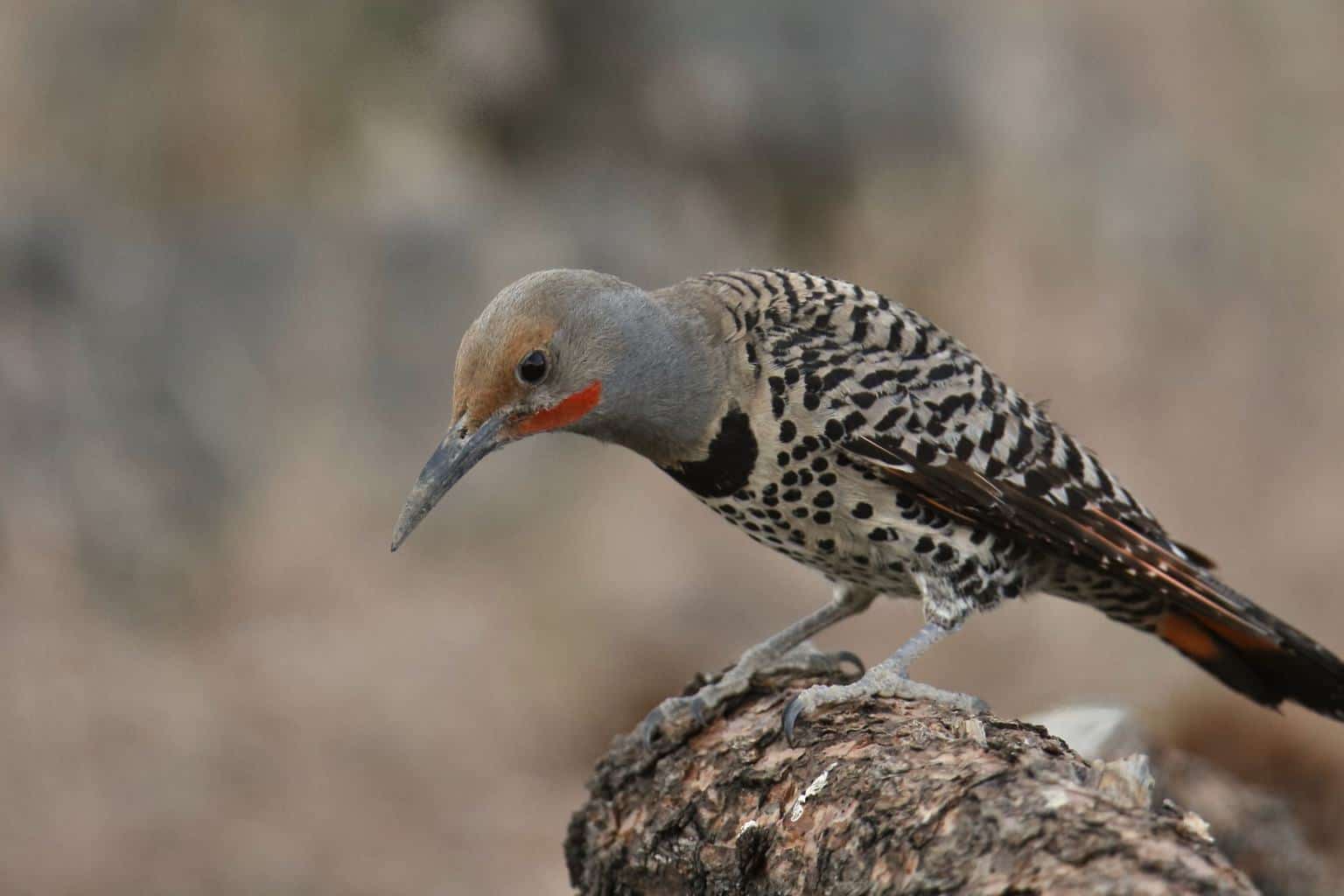
- Scientific Name: Colaptes auratus
- Length: 11 to 12.2 inches
- Weight: 3.9 to 5.6 ounces
- Wingspan: 16.5 to 20.1 inches
Unlike most woodpeckers in Northern America, Northern flickers’ general coloration is brown. They are mostly brown with black tails and black spots on their chests. They have a distinguishable black band on the upper part of their chests.
Like all woodpeckers, flickers are found in wooded regions throughout North America. Flickers tend to nest in open areas rather than in dense forests. For the most part, flickers find ants very tasty and abundant. They also consume other insects and little fruits and seeds.
These woodpeckers are special in every aspect, not just their looks. Despite being woodpeckers, Northern flickers are mainly ground feeders. They also have a distinctive call that sounds a lot like laughter.
Red-Tailed Hawk
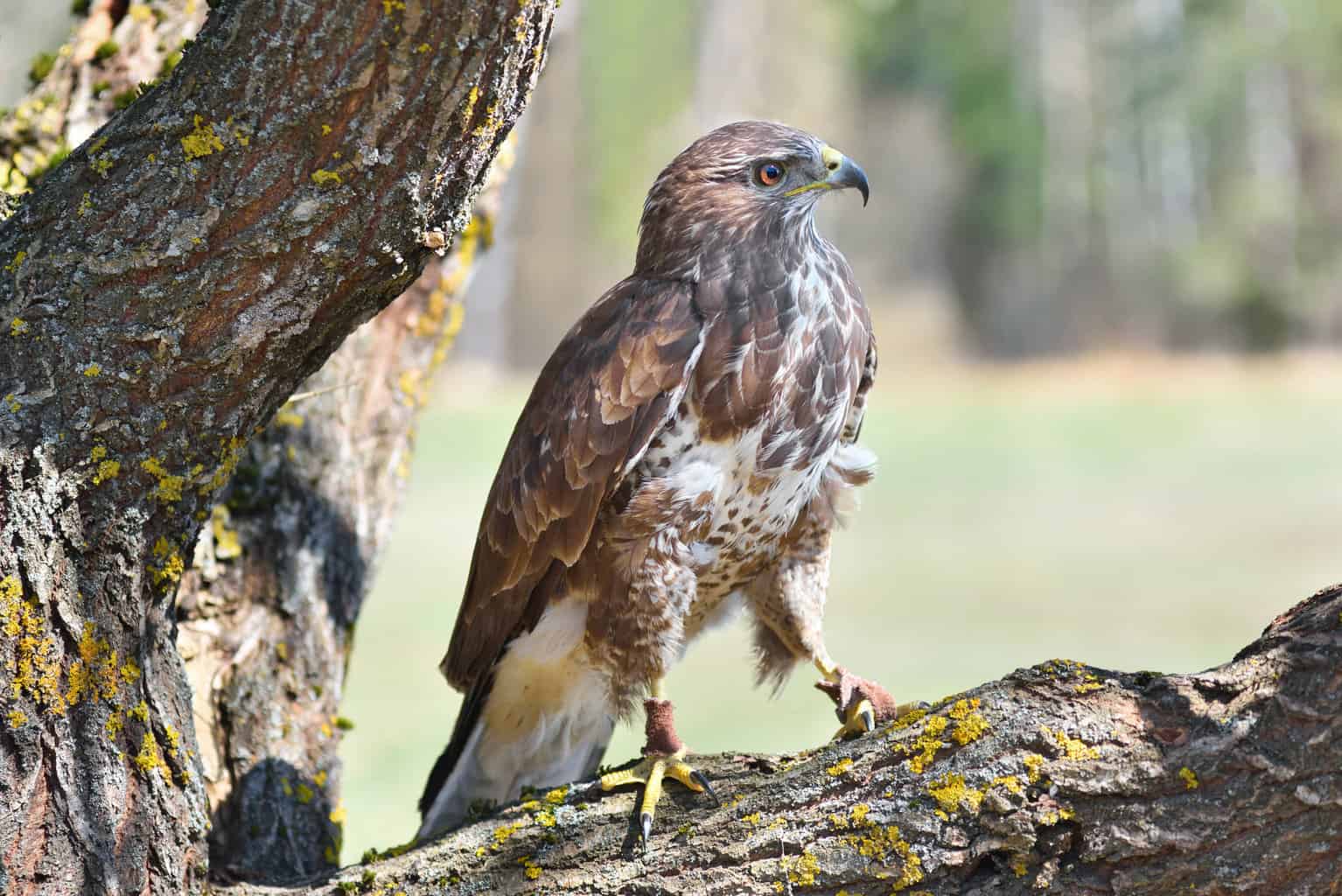
- Scientific Name: Buteo jamaicensis
- Length: 18 to 25 inches
- Weight: 2 to 4 pounds
- Wingspan: 4 feet
Red-tailed hawks have a wide range of colors in their plumage. They have dark brown heads and a dark band on their underwings called ‘patagial.’ They also have lighter bellies with dark streaks. These hawks have wide, deep rufous tails and a massive wingspan.
Like most hawks, Red-tailed hawks tend to be found in almost any habitat. The only determinant for their habitat is to be an open area with patches of elevated perches or trees.
Like all hawks, they are obviously carnivorous as they feed on small mammals, specifically having a taste for rabbits and rodents. Other animals can fall to the hawk’s claws, and it’s not picky. They seldom eat fish, reptiles, birds, or even large insects.
Downy Woodpecker
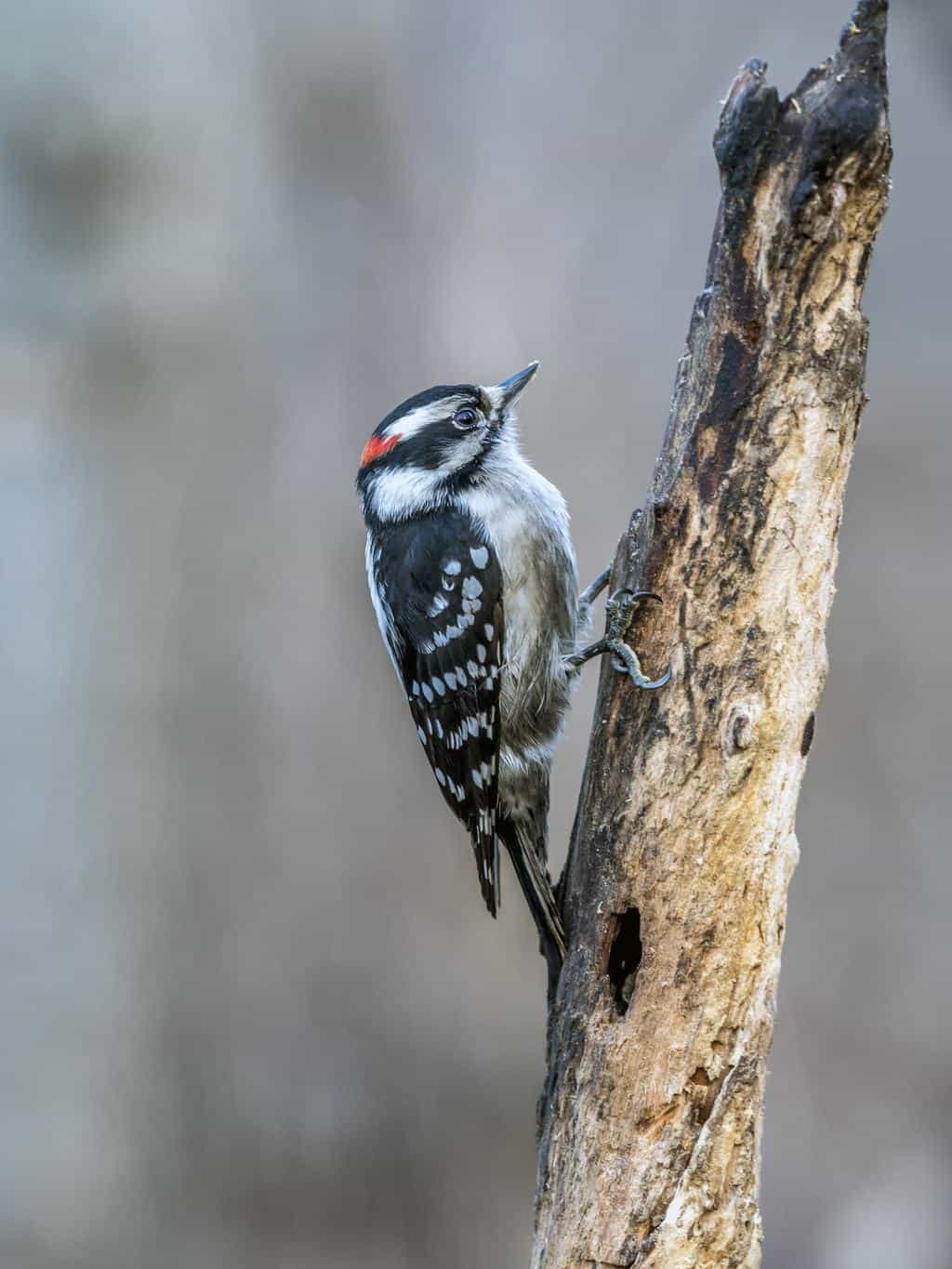
- Scientific Name: Picoides pubescens
- Length: 5.5 to 6.7 inches
- Weight: 0.7 to 1.0 ounces
- Wingspan: 9.8 to 11.8 inches
Small and adorable, Downy woodpeckers are the smallest woodpeckers in Washington. They are a mix of white and black, and the males have a red spot on their heads.
You can find these woodpeckers all year round in hardwood forests and, uncommonly, in the Palouse area. They’re also found near the Tri-cities and in the Columbia Basin.
Their diet consists mostly of insects, like ants and beetles. They also eat seeds, berries, and suet.
Both sexes assume equal roles during nesting. They both build the nest and feed the young.
Brown Pelican
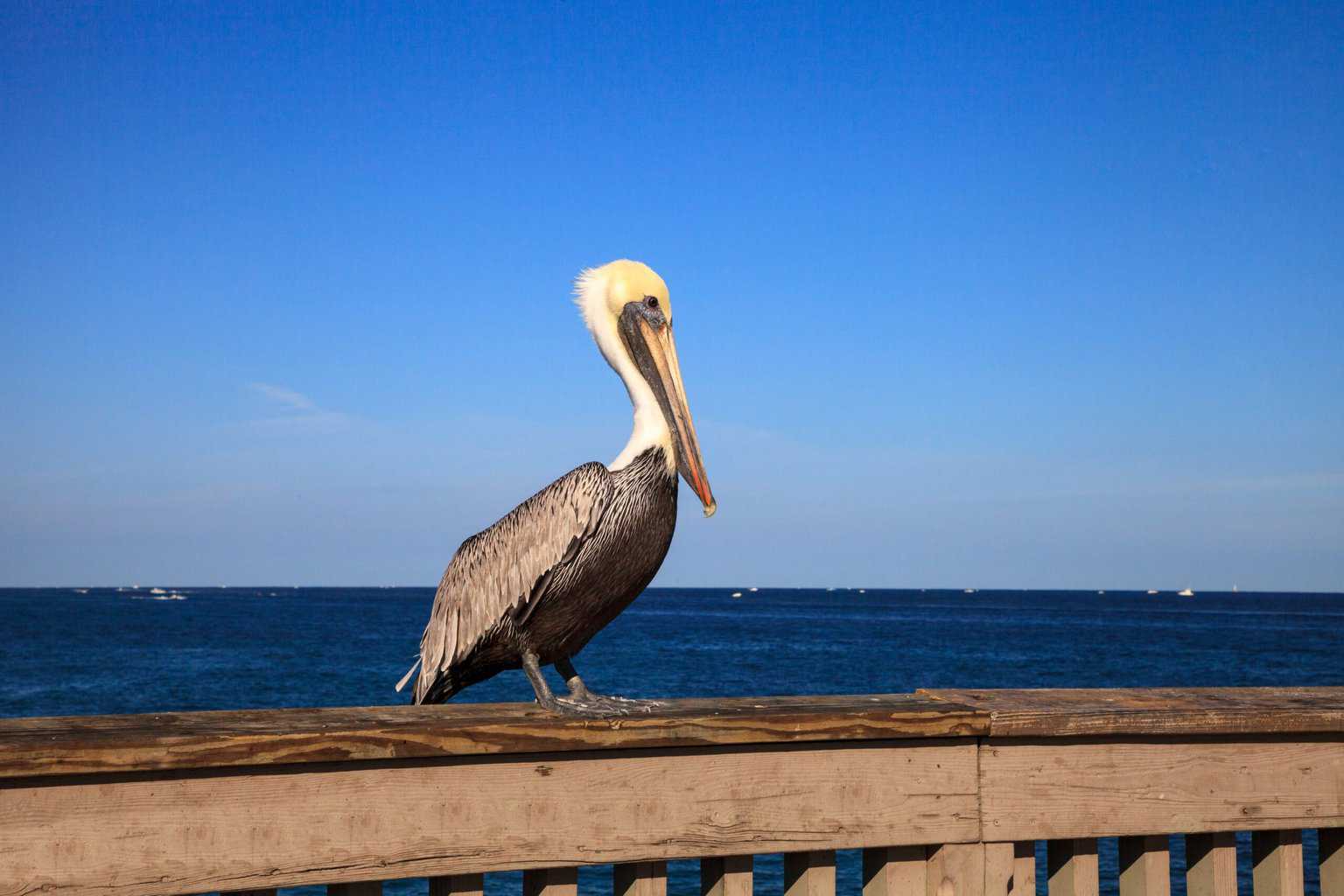
- Scientific Name: Pelecanus occidentalis
- Length: 39.4 to 53.9 inches
- Weight: 70.5 to 176 ounces
- Wingspan: 78.7 inches
This coastal bird has an enormous bill that it uses to catch fish. It’s a common sighting throughout Washington with its grayish-brown plumage and immense wingspan.
Look for Brown pelicans anywhere along the outer coast. The numbers are high from June to October.
Sandhill Crane
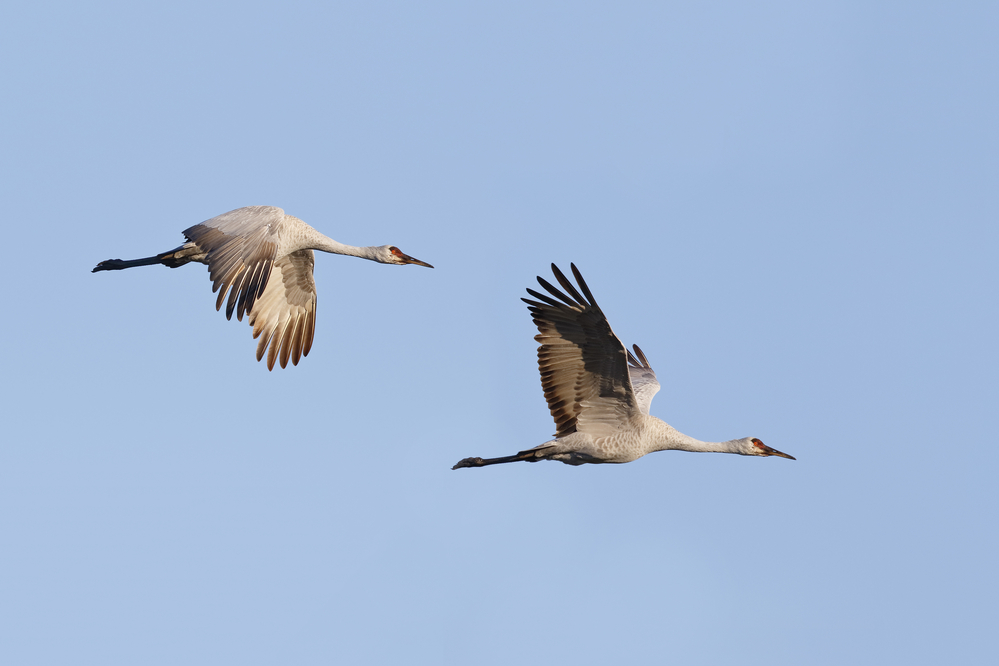
- Scientific Name: Grus canadensis
- Length: 47.2 inches
- Weight: 7.5 to 11 pounds
- Wingspan: 78.7 inches
These big birds are immensely large, sometimes exceeding four feet in length. They are mostly gray but are distinguishable by their red crowns.
There are officially two sites in Washington where you can spot Sandhill cranes. The first is at the Yakama Indian Reservation, and the second is at Conboy Lake National Wildlife Refuge.
Common Poorwill
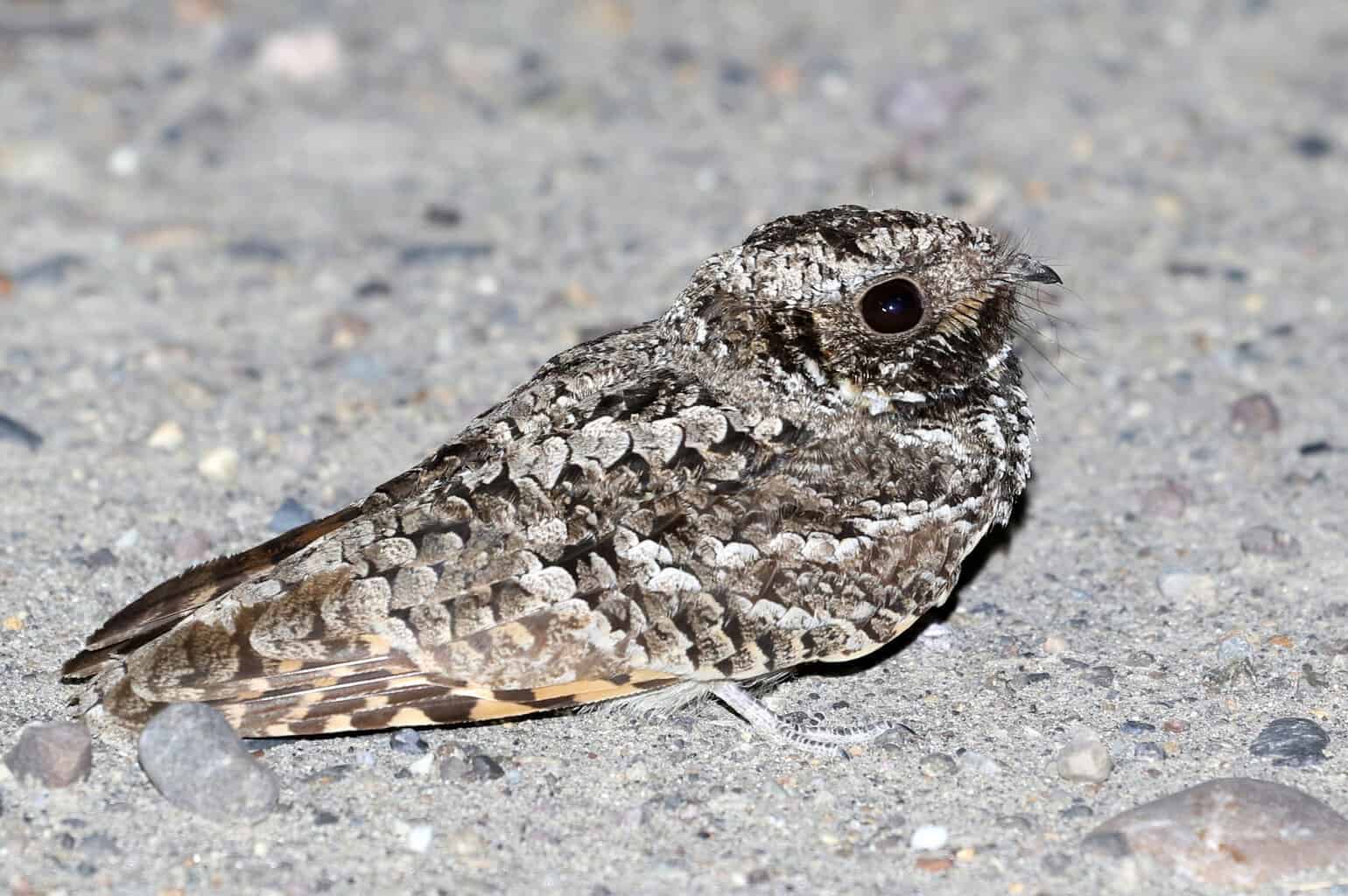
- Scientific Name: Phalaenoptilus nuttallii
- Length: 7.1 inches
- Weight: 1.3 to 2 ounces
- Wingspan: 12 inches
You’ve probably heard a Common poorwill before but never seen it. These cryptic birds are very small and mottled brown and gray. Their vocalizing sounds like someone is shouting “Poor Will,” which is how they got their name.
If you want to spot one in Washington, try your luck in shrubby areas between the ecotone and the Ponderosa pine forests. Sightings have also been reported in western Washington, although they’re extremely rare.
Band-Tailed Pigeon
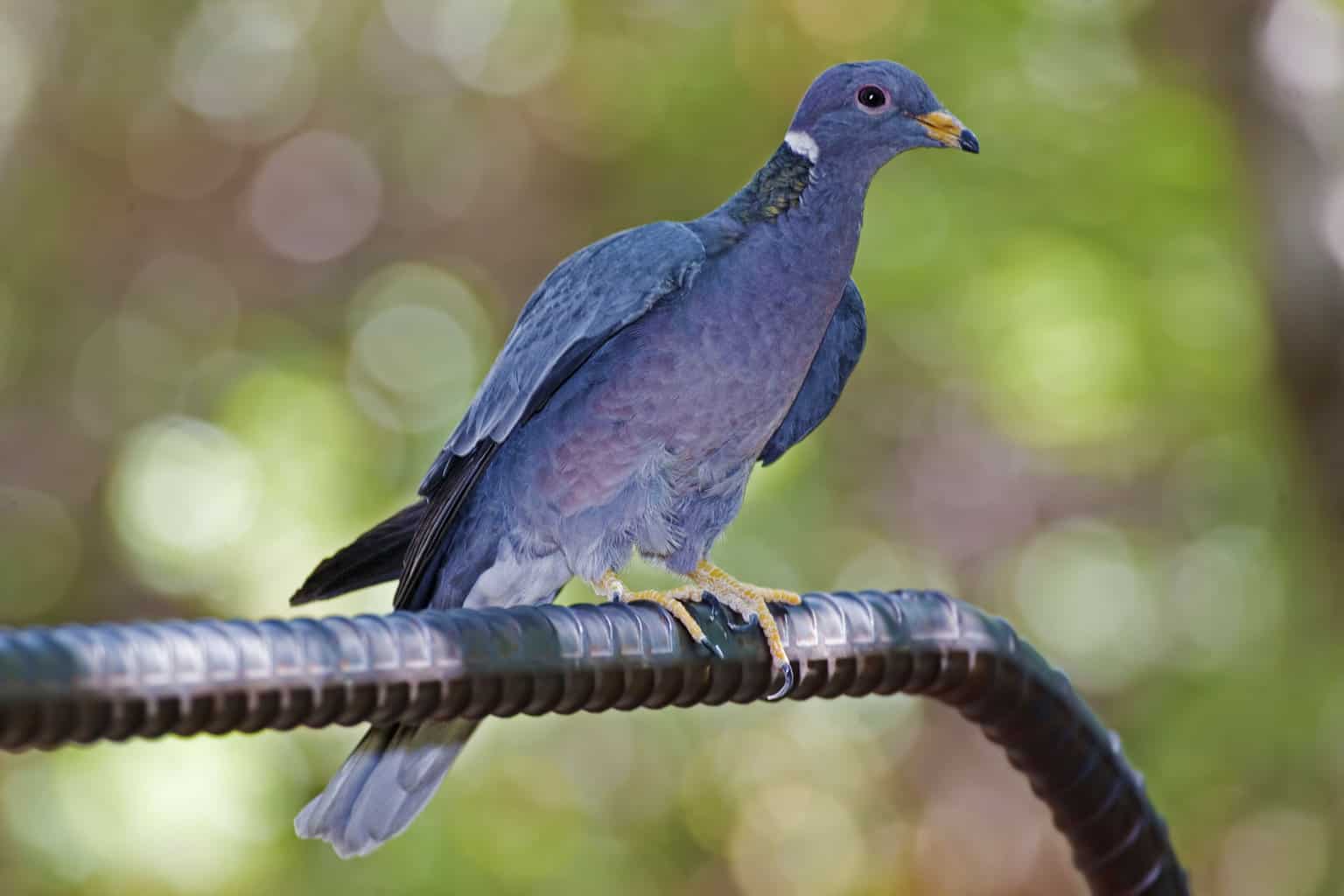
- Scientific Name: Patagioenas fasciata
- Length: 13 to 16 inches
- Weight: 7.9 to 18.2 ounces
- Wingspan: 26 inches
This soft gray pigeon looks almost identical to the Rock pigeon. It’s sleeker and longer, and you can distinguish it from the light gray banded tail.
Band-tailed pigeons can be found just as commonly as Rock pigeons. Look for them in city parks, lowlands, residential areas, and open forests. They’re rarely found in eastern Washington.
Common Nighthawk
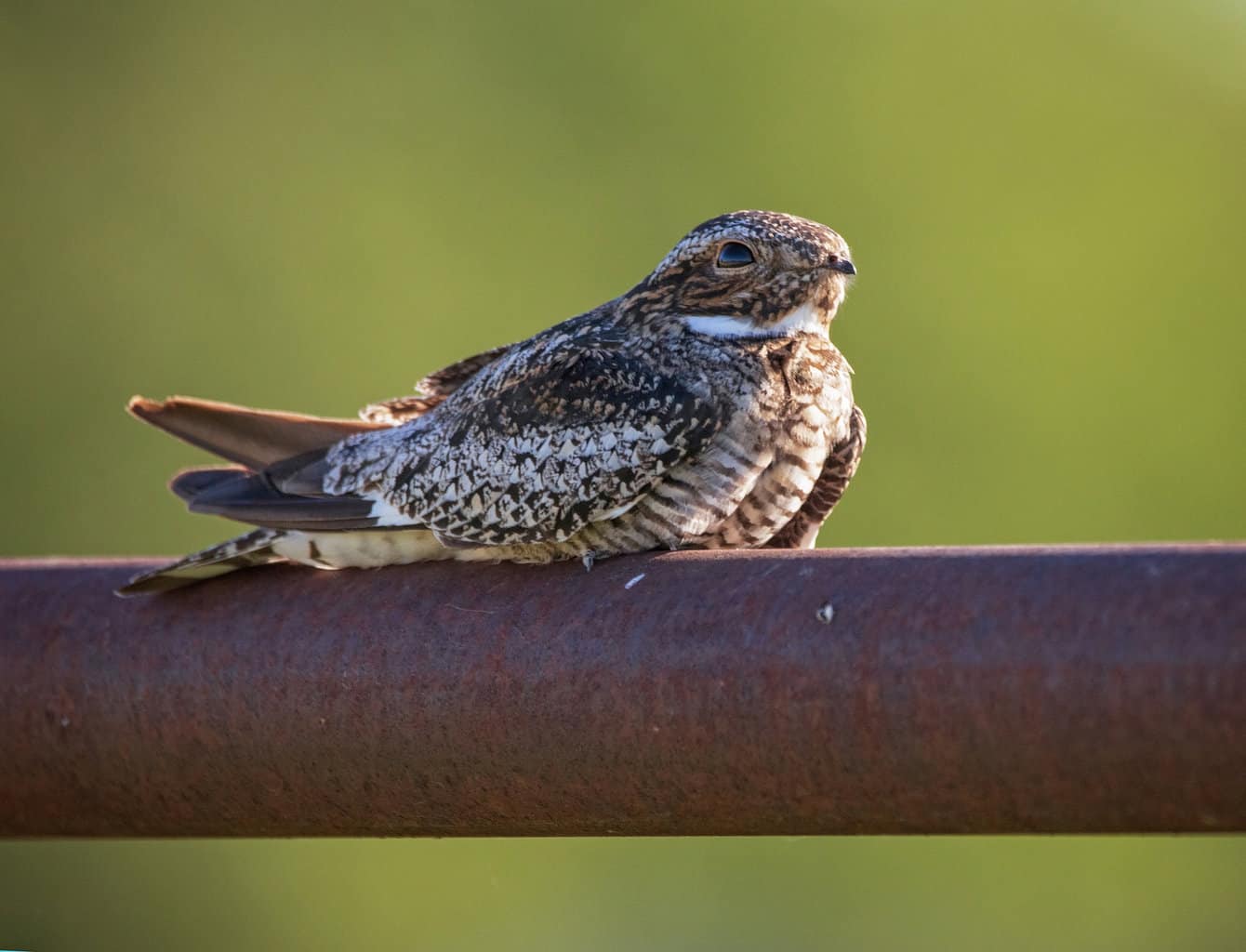
- Scientific Name: Chordeiles minor
- Length: 8.7 to 9.4 inches
- Weight: 2.3 to 3.5 ounces
- Wingspan: 20.9 to 22.4 inches
You’ll probably never see a Common nighthawk on the ground. These birds are almost always seen when they’re flying. They’re easily distinguishable by a white bar across each wing. They’re gray and black and have tiny beaks.
You can spot Common nighthawks in the Columbia Basin in the open desert. You can also spot a few in western Washington if you go out to Ocean Shores, but only from June until September.
Wrapping Up
Washington is one of the most diverse states in terms of bird species. From woodpeckers and warblers to hawks and plovers, you can potentially spot hundreds of different bird species in your backyard!

